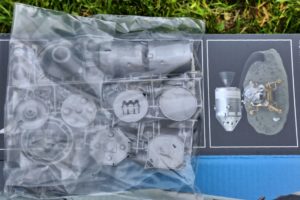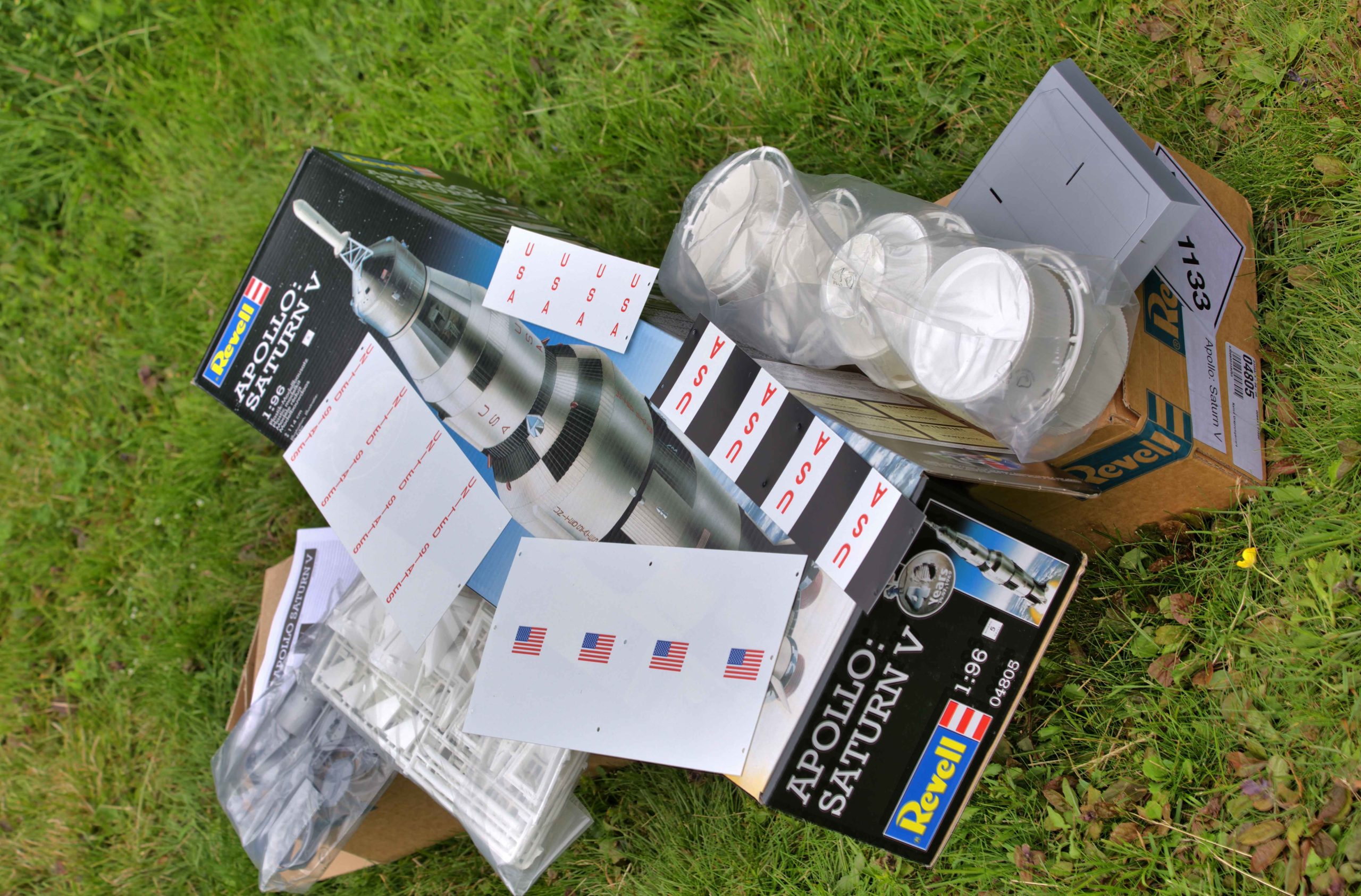Revell Apollo 11 Saturn V Rocket (04805)
Post Space Race with Revell – Part 1 describes the circumstances that led to the Apollo programme. The first studies for the Saturn rocket were made as early as 1959, two years before J. F. Kennedy's famous speech: We choose to go to the Moon. Thus 1961 was the official birth of the programme. Following the example of conservative engineering, the concept was broadly conceived. It soon became clear that a three-stage rocket was needed, because it was essential to get rid of the empty heavy shells one by one. The Soviet design and the NASA design differed on one, perhaps crucial, point that Dr. Wernher von Braun had also considered carefully. How many propulsion engines does the first stage use. The decision directly affects the diameter of the first stage and, as is the case with foundations, what is built on top of it. So the vehicle had to be designed, but also the knowledge and training of the crew of a manned space flight. Thus, in addition to the Apollo missions, the Gemini programme was created, whose task was to test the necessary spacecraft manoeuvres in orbit on a small scale, but also to let the astronauts leave their ship and navigate. Just as the Atlas rocket of the Mercury programme came from military funding, the Titan-II for Gemini was chosen from the field of state-of-the-art military intercontinental ballistic missiles. The Titan was notable for its reliability. It completed two unmanned test flights in April 1964 and January 1965 and all 12 Gemini flights from March 1965 onwards, with the 18 astronauts eventually finding their way back to Earth unharmed. From Gemini-6 onwards, rendezvous in orbit were to take place. Thus, prior to the launch of the Gemini rocket manned in pairs, an unmanned Agena upper stage was launched into orbit. Both the Atlas from the Mercury programme and the Titan rocket from the manned Gemini launches were used as launch vehicles. The Agena upper stage had already been ordered earlier by the US Airforce as a satellite, which was equipped accordingly depending on the mission purpose. The Agena stage for the Gemini-6 launch did not reach orbit, so it failed. It was not until Gemini-8 that an Agena upper stage was again ready to fly into space and 100 minutes later the actual manned Gemini-8 crew launched and docked with the Agena for its exercises. Gemini-9 was also to perform another docking manoeuvre, but the two half-shells enclosing the docking area at the top of the rocket during Agena's ascent phase only partially opened. This left only one beautiful shot, which earned this Agena the nickname "angry alligator" for Gemini-9.

Gemini-9 - Augmented Target Docking Adapter: The angry alligator (From NASA - Great Images in NASA Description, public domain)
The final Gemini flight, Gemini-12, then took place in June 1966, four months after the first rocket carrying Apollo spacecraft components was successfully launched. The first Apollo mission was carried out with the two-stage Saturn-IB, the Apollo capsule was tested unmanned on this flight, re-entry being the challenge here. The cheaper two-stage design was sufficient here, as it was only for Earth-orbital testing. The upper stage then remained conceptually the same for all Saturn rockets. The first tests of the Saturn-IB date back to October 1961, when the individual stages were successively tested, especially the upper stage, until the first Saturn-V was finally launched into space with Apollo-4 in November 1967. Before that, there had been 13 launches of Saturn I or Saturn-IB. The 14th launch of the Saturn-IB could not take place because one month before the launch date, the Apollo module burned out during an exercise with the astronauts on board. The accident led to the entire vehicle being rechecked for safety, and as a result it was greatly improved.
And after this introductory prehistory, it may be due to the founding year of the Revell company in 1956 that it was not possible to concentrate so intensively on space travel. After all, competing companies had already been established on the market for 15 years or more, so it was certainly necessary to quickly develop a broad base of models. Thus, apart from the A-4, which was founded in the German history, other models from the space programme were left out by Revell. With the Saturn-V, first edition in 1969 in 1/96 scale, the first rocket came on the market, just in time for the first moon flight with Apollo-11 on 20 July of that year. About every 13 years, the model reappears in new, but unchanged productions. Presumably due to the early edition or the secret construction plans, the model shows deviations from the original. Thus a marketplace has developed for the Saturn-V to supersize the Revell model, especially if the model is to be broken down into the individual stages, as it is, for example, in the museum in Cape Canaveral. The company New Ware , for example, specialises in this. What else exciting has been developed from this Saturn V kit at Revell? Well, there is another 03700 kit that contains just the Apollo spacecraft, that is the Command Service Module and the Lunar Module. So the spacecraft can be built coupled but also separated with the lunar module landed.

Mouldings for the Revell 03700 from the Apollo Box

